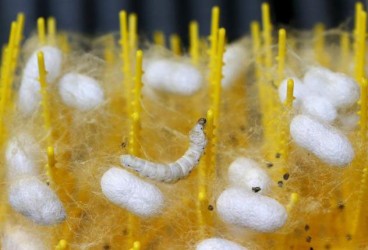CASTELFRANCO VENETO, ITALY (Reuters) – Clusters of silkworms munch on piles of locally-grown mulberry leaves in a white marquee in Italy’s northern Veneto region. They are nourishing hopes of a revival of Italy’s 1,000 year-old silk industry.

Decades after Veneto’s last silk mills were shuttered as a post-war economic boom lured farmers to cities, budding silkmakers – or “sericulturists” – are trying to spin a niche around a traceable supply chain of high-quality material.
“This is a new beginning for a sector that was vital until 50 years ago,” said Giampietro Zonta, a jeweler who started producing his own silk last year in order to make a line of bracelets and necklaces made of interwoven gold and silk. Zonta’s company D’Orica has joined forces with a scientific research center and three agricultural cooperatives to produce the silk from scratch. Last year, they harvested 800 grams.
This budding silk industry is minuscule compared to the 130,000 tonnes of silk China manufactured in 2013, according to the International Sericultural Commission.
Italy – which is one of the world’s major importers – uses the mainly Chinese silk to make finished fabric, neckties, scarves, shirts and dresses which had a combined export value of more than 890 million euros ($975 million) in 2012, according to trade body Ufficio Italiano Seta.
Yet Zonta’s project is one of various efforts cropping up across Italy led by entrepreneurs wanting to capitalize on a timid economic recovery to launch businesses tied to the country’s traditional specialities – in this case, fashion.
Italian entrepreneurship is still suffering after two decades of economic stagnation and three years of recession, but there are signs of a recovery, according to the national union of chambers of commerce Unioncamere. Fewer new ventures opened in the first quarter of 2015 than in the same period of last year, but the number of closures dropped more sharply, Unioncamere says.
The effort also speaks to a very gradual shift in the economics of overseas production as rising salaries in Asia nibble at fat profit margins that have long lured European companies to produce abroad.
Overall manufacturing costs are still 30 per cent higher in Italy than China, but companies including Italian leather goods brand Piquadro have brought some production home, thereby saving on transport costs and import duties. Italy’s silkmakers say that producing locally allows for stricter quality control. Fashion industry body Sistema Moda Italia says textile producers pay around 48 euros ($53) a kilogramme to import the raw material, but buyers of silk for other specialized uses like skincare say they will pay more for the locally-grown quality guarantee.
Alessandro Di Grazia, product developer at Italian dental product maker FIMO, branched out into skincare to make a sort of thimble made of a silkworm cocoon for cleaning the skin. He buys Veneto-grown cocoons for 0.6 euros each to use in the product, a certified medical device sold in pharmacies.
“Using Italian silk is very important to us because we know who has made it and how. For our purposes we need extremely clean cocoons,” said Di Grazia.
The Silk Road
Silkworm eggs and rearing techniques came to Europe from Asia along the trade routes known as the “Silk Road”. They arrived around the year 1000 in Italy, where production reached a peak in the late 1800s with output topping 60,000 tonnes of cocoons a year.
But two world wars in quick succession at the beginning of the twentieth century changed the social and economic fabric of Europe. Soon after the second conflict, Italy began a period of industrialization which was to spell the end of sericulture.
Now the industry in China, which makes some 85 percent of the world’s silk, is under pressure from its own economic boom, said Kurada Keshendra Shetty of the Bangalore-based International Sericultural Commission.
“Due to rapid industrialization and urbanization, silk production in the country may decline considerably in the coming years,” Shetty said.
As part of the process of industrialization, young Chinese people are losing interest in sericulture and “many young farmers rush into (the) city to earn more money”, said Dr. Long Li, deputy director of the Sericultural Research Institute at the Chinese Academy of Agricultural Sciences.
Meanwhile, demand for silk is rising as people in China and India get richer, according to Shetty, and “there is an immediate need to start up the silk industry in new places”.





